Geometry | Term 2 Chapter 4 | 7th Maths - Exterior Angles | 7th Maths : Term 2 Unit 4 : Geometry
Chapter: 7th Maths : Term 2 Unit 4 : Geometry
Exterior Angles
Exterior Angles
We know that any triangle is made up of three vertices, three sides and three angles. Now observe the triangle given in Fig. 4.9
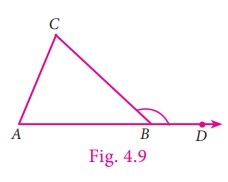
In ∆ABC, the side AB is extended to D. Observe ∠CBD side which is formed by the BC and BD. ∠CBD is known as the exterior angle of ∆ABC at B.
We can observe that, ∠ABC and ∠CBD are adjacent and they form a linear
pair.
Besides, the other two angles namely,
∠CAB and ∠ACB are non-adjacent angles to ∠CBD. They are called interior opposite angles of ∠ CBD.
Think
Can CB be extended to F to get another exterior angle of ∆ABC at B?
Note
In ∆ABC, we can
also extend the sides BC to E and CA to F to form exterior
angles at C and A.
Exterior Angle Properties
of a Triangle
Activity
To understand exeterior
angle properties of a triangle list all the exterior angles of triangles that are
shown below.

Measure and express each
exterior angle as a sum of its interior opposite angles and complete the table.
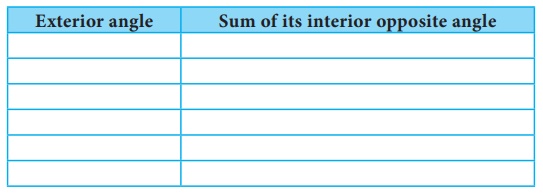
From the above activity we observe that
an exterior angle of a triangle is equal to the sum of its interior opposite angles.
Now we prove this result in a formal
method.
Proof
In ∆ABC, consider, the angles at A,
B and C as a, b and c respectively and take exterior
angles at A, B and C as x, y and z respectively.
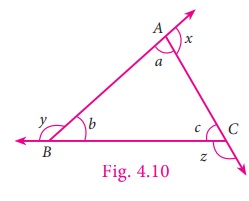
We are going to prove x=b+c,
y=a+c and z=a+b
a + x = 180° [linear pair of
angles are supplementary]
This gives, x = 180° – a … (1)
Now, a + b + c =
180° [Sum of 3 angles in a triangle is 180°]
This gives, b + c = 180°
– a …(2)
From (1) and (2),
x and b + c both are equal.
Therefore, x = b + c.
In the same way, we can prove the result
for other exterior angles.
Now we are going to learn one more result
on the exterior angle of a triangle for which we do the following activity.
Activity
Imagine a person standing
in one of the vertices (corners) and walking along the boundary of the triangle
until he reaches the starting point. At each of the vertex of the triangle he would
turn an angle equal to the exterior angle at that vertex. Hence after the complete
journey around the triangle he would have turned through an angle equal to one complete
revolution, that is 360°.
We prove this result as below.
Since the angles on a straight line is
180º
,
We have a + x = 180° [linear pair of angles are supplementary]
x = 180° – a
Similarly, y = 180° –b
and z = 180° – c
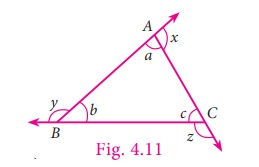
Therefore, x + y + z = (180° –
a) + (180° – b) + (180° – c)
= 540 – (a
+ b + c)
=540°–180° [sum of all three angles
of a triangle is 180°]
=360°
Hence, the sum of all exterior angles
of a triangle is 360°.
Therefore, the properties of exterior
angle gives us the following two results.
(i) An exterior
angle of a triangle is equal to the sum of its interior opposite angles.
(ii) The sum of exterior angles of a
triangle is 360º .
Example 4.5
In ∆PQR , find the exterior angle,
∠SRQ .
Solution
Let, ∠SRQ = x

Exterior angle =
sum of two interior opposite angles
x= 38° + 44° = 82°
Example 4.6
In ∆LMN , LM is extended
to O. If ∠L = 62° and ∠N = 31°, find ∠NMO .
Solution
Let, ∠NMO = y
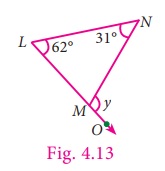
Exterior angle =
sum of two interior opposite angles
y= 62° +31°
= 93°
Example 4.7
In the ∆ABC shown in the figure, find
the angel z.

Solution
Exterior angle =
sum of two interior opposite angles
135° = z +
40°
Subtract 40° on both sides
135° − 40° =
z + 40° − 40°
z= 95°
Example 4.8
In the given isoceles triangle
IJK (Fig. 4.15), if ∠IKL = 128°, find the value of x.
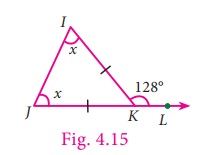
Solution
Exterior angle =
sum of two interior opposite angles
128° = x +
x
128= 2x
128/2 = 2x/2
[on both sides,
divide by 2]
x= 64°
Example 4.9
With the given data in the
Fig. 4.16, find ∠UWY . What do you infer about ∠XWV ?
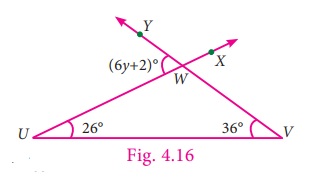
Solution
Exterior angle = sum of two interior
opposite angles
6 y +
2 = 26° + 36°
6
y + 2 = 62°
Subtract 2 from both sides
6 y =
62 –
2
6 y =
60°
6y/6 = 60/6 [on both sides,
divide by 6]
y=10º
∠UWY = 6y + 2 = 6(10) + 2 = 62º
.
We can conclude that ∠XWV = ∠UWY , because they are vertically opposite
angles as well as exterior angles.
Related Topics